Temperature Dependence of Magnetization Dynamics in Co/IrMn and Co/FeMn Exchange Biased Structures
Abstract
:1. Introduction
2. Materials and Methods
3. Results
3.1. Structure Properties
3.2. Roughness and Graininess
3.3. Magnetostatic Measurements
3.4. Ferromagnetic Resonance
4. Discussion
5. Conclusions
Author Contributions
Funding
Institutional Review Board Statement
Informed Consent Statement
Data Availability Statement
Acknowledgments
Conflicts of Interest
References
- Pişkin, H.; Akdoğan, N. Interface-induced enhancement of sensitivity in NiFe/Pt/IrMn-based planar hall sensors with nanoTesla resolution. Sens. Actuator A Phys. 2019, 292, 24–29. [Google Scholar] [CrossRef]
- Roy, A.; Sampathkumar, P.; Kumar, P.S.A. Development of a very high sensitivity magnetic field sensor based on planar Hall effect. Measurement 2020, 156, 107590. [Google Scholar] [CrossRef]
- Thanh, N.T.; Tu, L.T.; Ha, N.; Kim, C.O.; Kim, C.G.; Shin, K.H.; Rao, B.P. Thickness dependence of parallel and perpendicular anisotropic resistivity in Ta/NiFe/IrMn/Ta multilayer studied by anisotropic magnetoresistance and planar Hall effect. Appl. Phys. 2007, 101, 053702. [Google Scholar] [CrossRef]
- Choi, E.Y.; Kim, J.H.; Seo, J.W.; Lee, A.-Y.; Park, S.Y.; Lee, S.-S. A study on the temperature dependence of exchange bias on the planar Hall effect of NiFe/IrMn bilayer. New Phys. Sae Mulli 2022, 72, 355–359. [Google Scholar] [CrossRef]
- Mendes, J.B.S.; Cunha, R.O.; Santos, O.A.; Ribeiro, P.R.T.; Machado, F.L.A.; Rodríguez-Suárez, R.L.; Azevedo, A.; Rezende, S.M. Large inverse spin Hall effect in the antiferromagnetic metal Ir20Mn80. Phys. Rev. B 2014, 89, 140406. [Google Scholar] [CrossRef]
- Lin, P.H.; Yang, B.Y.; Tsai, M.H.; Chen, P.-C.; Huang, K.-F.; Lai, C.-H. Manipulating exchange bias by spin–orbit torque. Nature Mater. 2019, 18, 335–341. [Google Scholar] [CrossRef]
- Wang, X.; Wan, C.; Liu, Y.; Shao, Q.; Wu, H.; Guo, C.; Fang, C.; Guang, Y.; Yang, W.; He, C.; et al. Spin transmission in IrMn through measurements of spin Hall magnetoresistance and spin-orbit torque. Phys. Rev. B 2020, 101, 144412. [Google Scholar] [CrossRef]
- Zhang, W.; Jungfleisch, M.B.; Jiang, W.; Pearson, J.E.; Hoffmann, A.; Freimuth, F.; Mokrousov, Y. Spin Hall effects in metallic antiferromagnets. Phys. Rev. Lett. 2014, 113, 196602. [Google Scholar] [CrossRef]
- Tshitoyan, V.; Ciccarelli, C.; Mihai, A.P.; Ali, M.; Irvine, A.C.; Moore, T.A.; Jungwirth, T.; Ferguson, A.J. Electrical manipulation of ferromagnetic NiFe by antiferromagnetic IrMn. Phys. Rev. B 2015, 92, 214406. [Google Scholar] [CrossRef]
- Fukami, S.; Zhang, C.; DuttaGupta, S.; Kurenkov, A.; Ohno, H. Magnetization switching by spin-orbit torque in an antiferromagnet-ferromagnet bilayer system. Nat. Mater. 2016, 15, 535–541. [Google Scholar] [CrossRef]
- Alayo, W.; Baggio-Saitovitch, E.; Pelegrini, F.; Nascimento, V.P. Oscillations of the ferromagnetic resonance linewidth and magnetic phases in Co/Ru superlattices. Phys. Rev. B 2008, 78, 134417. [Google Scholar] [CrossRef]
- Azevedo, A.; Oliveira, A.B.; de Aguiar, F.M.; Rezende, S.M. Extrinsic contributions to spin-wave damping and renormalization in thin Ni50Fe50 films. Phys. Rev. B 2000, 62, 5331–5333. [Google Scholar] [CrossRef]
- Jeyaramane, A.C.; Prasad, C.D.V. Magnetization and magnetic microscopy studies in Fe thin films. J. Electron. Mater. 2021, 50, 1119–1131. [Google Scholar] [CrossRef]
- McMichael, R.D.; Stiles, M.D.; Chen, P.J.; Egelhoff, W.F., Jr. Ferromagnetic resonance studies of NiO-coupled thin films of Ni80Fe20. Phys. Rev. B 1998, 58, 8605–8612. [Google Scholar] [CrossRef]
- Geshev, J.; Pereira, L.G.; Schmidt, J.E. Rotatable anisotropy and coercivity in exchange-bias bilayers. Phys. Rev. B 2002, 66, 134432. [Google Scholar] [CrossRef]
- Polishchuk, D.M.; Polek, T.I.; Borynskyi, V.Y.; Kravets, A.F.; Tovstolytkin, A.I.; Korenivski, V. Isotropic FMR frequency enhancement in thin Py/FeMn bilayers under strong magnetic proximity effect. J. Phys. D Appl. Phys. 2021, 54, 305003. [Google Scholar] [CrossRef]
- Arana, M.; Gamino, M.; Oliveira, A.B.; Holanda, J.; Azevedo, A.; Rezende, S.M.; Rodríguez-Suárez, R.L. Unraveling intricate properties of exchange-coupled bilayers by means of broadband ferromagnetic resonance and spin pumping experiments. Phys. Rev. B 2020, 102, 104405. [Google Scholar] [CrossRef]
- Azzawi, S.; Hindmarch, A.T.; Atkinson, D. Magnetic damping phenomena in ferromagnetic thin-films and multilayers. J. Phys. D Appl. Phys. 2017, 50, 473001. [Google Scholar] [CrossRef]
- Zakeri, K.; Lindner, J.; Barsukov, I.; Meckenstock, R.; Farle, M.; von Hörsten, U.; Wende, H.; Keune, W.; Rocker, J.; Kalarickal, S.S.; et al. Spin dynamics in ferromagnets: Gilbert damping and two-magnon scattering. Phys. Rev. B 2007, 76, 104416. [Google Scholar] [CrossRef]
- de Sihues, M.D.; Durante-Rincón, C.A.; Fermin, J.R. A ferromagnetic resonance study of NiFe alloy thin films. J. Magn. Magn. Mater. 2007, 316, e462–e465. [Google Scholar] [CrossRef]
- Gallardo, R.A.; Rodríguez-Suárez, R.L.; Landeros, P. Defect-induced magnon scattering mechanisms in exchange-coupled bilayers. J. Appl. Phys. 2016, 120, 223904. [Google Scholar] [CrossRef]
- Rodríguez-Suárez, R.L.; Vilela-Leáo, L.H.; Bueno, T.; Oliveira, A.B.; de Almeida, J.R.L.; Landeros, P.; Rezende, S.M.; Azevedo, A. Critical thickness investigation of magnetic properties in exchange-coupled bilayers. Phys. Rev. B 2011, 83, 224418. [Google Scholar] [CrossRef]
- Woltersdorf, G.; Kiessling, M.; Meyer, G.; Thiele, J.-U.; Back, C.H. Damping by slow relaxing rare earth impurities in Ni80Fe20. Phys. Rev. Lett. 2009, 102, 257602. [Google Scholar] [CrossRef] [PubMed]
- Verhagen, T.G.A.; Tinkey, H.N.; Overweg, H.C.; van Son, M.; Huber, M.; van Ruitenbeek, J.M.; Aarts, J. Temperature dependence of spin pumping and Gilbert damping in thin Co/Pt bilayers. J. Phys. Condens. Matter 2016, 28, 056004. [Google Scholar] [CrossRef] [PubMed]
- Mizukami, S.; Ando, Y.; Miyazaki, T. The study on ferromagnetic resonance linewidth for NM/80NiFe/NM (NM = Cu, Ta, Pd and Pt) films. Jpn. J. Appl. Phys. 2001, 40, 580–585. [Google Scholar] [CrossRef]
- Goyat, E.; Behera, N.; Barwal, V.; Siwach, R.; Goyat, G.; Gupta, N.K.; Pandey, L.; Kumar, N.; Hait, S.; Chaudhary, S. Large exchange bias and spin pumping in ultrathin IrMn/Co system for spintronic device applications. Appl. Surf. Sci. 2022, 588, 152914. [Google Scholar] [CrossRef]
- Yuan, S.; Kang, B.; Yu, L.; Cao, S.; Zhao, X. Increased ferromagnetic resonance linewidth and exchange anisotropy in NiFe/FeMn bilayers. J. Appl. Phys. 2009, 105, 063902. [Google Scholar] [CrossRef]
- Lubitz, P.; Krebs, J.J.; Miller, M.M.; Cheng, S. Temperature dependence of ferromagnetic resonance as induced by NiO pinning layers. J. Appl. Phys. 1998, 83, 6819–6821. [Google Scholar] [CrossRef]
- Sakimura, H.; Asami, A.; Harumoto, T.; Nakamura, Y.; Shi, J.; Ando, K. Enhancement of two-magnon scattering induced by a randomly distributed antiferromagnetic exchange field. Phys. Rev. B 2018, 98, 144406. [Google Scholar] [CrossRef]
- Rezende, S.M.; Azevedo, A.; Lucena, M.A.; de Aguiar, F.M. Anomalous spin-wave damping in exchange-biased films. Phys. Rev. B 2001, 63, 214418. [Google Scholar] [CrossRef]
- Liu, Y.; Lan, Z.; Yu, Z.; Guo, R.; Jiang, X.; Wu, C.; Sun, K. Regulation of microstructure, static, and microwave magnetic performance of NiFe/FeMn/NiFe heterogeneous multilayer films based on thickness of FeMn films. J. Supercond. Nov. Magn. 2020, 34, 531–538. [Google Scholar] [CrossRef]
- Haidar, M.; Isber, S.; Åkerman, J. Measuring spin wave resonance in Ni100−xFex films: Compositional and temperature dependence. J. Phys. D Appl. Phys. 2021, 54, 445002. [Google Scholar] [CrossRef]
- Safonov, V.L.; Bertram, H.N. Linear stochastic magnetization dynamics and microscopic relaxation mechanisms. J. App. Phys. 2003, 94, 529–538. [Google Scholar] [CrossRef]
- Ebert, H.; Mankovsky, S.; Ködderitzsch, D.; Kelly, P.J. Ab initio calculation of the Gilbert damping parameter via the linear response formalism. Phys. Rev. Lett. 2011, 107, 066603. [Google Scholar] [CrossRef]
- Pechan, M.J.; Bennett, D.; Teng, N.; Leighton, C.; Nogues, J.; Schuller, I.K. Induced anisotropy and positive exchange bias: A temperature, angular, and cooling field study by ferromagnetic resonance. Phys. Rev. B 2002, 65, 064410. [Google Scholar] [CrossRef]
- Lubitz, P.; Rubinstein, M.; Krebs, J.J.; Cheng, S.-F. Frequency and temperature dependence of ferromagnetic linewidth in exchange biased Permalloy. J. Appl. Phys. 2001, 89, 6901–6903. [Google Scholar] [CrossRef]
- Lew, W.S.; Ercole, A.; Lauhoff, G.; Kernohan, E.T.M.; Lee, J.; Bland, J.A.C. Temperature dependence of spin waves in Co/CoO bilayers. J. Appl. Phys. 2001, 89, 7654–7656. [Google Scholar] [CrossRef]
- Ercole, A.; Lew, W.S.; Lauhoff, G.; Kernohan, E.T.M.; Lee, J.; Bland, J.A.C. Temperature-dependent spin-wave behavior in Co/CoO bilayers studied by Brillouin light scattering. Phys. Rev. 2000, 62, 6429. [Google Scholar] [CrossRef]
- Rubinstein, M.; Lubitz, P.; Cheng, S.-F. Ferromagnetic-resonance field shift in an exchange-biased CoO/Ni80Fe20 bilayer. J. Magn. Magn. Mater. 1999, 195, 299–306. [Google Scholar] [CrossRef]
- Dubowik, J.; Stobiecki, F.; Gościańska, I.; Lee, Y.P.; Paetzold, A.; Röll, K. Temperature dependence of ferromagnetic resonance in permalloy/NiO exchange-biased films. Eur. Phys. J. B 2005, 45, 283–288. [Google Scholar] [CrossRef]
- Gloanec, M.; Rioual, S.; Lescop, B.; Zuberek, R.; Szymczak, R.; Aleshkevych, P.; Rouvellou, B. Temperature dependence of exchange bias in NiFe/FeMn bilayers. Phys. Rev. B 2010, 82, 144433. [Google Scholar] [CrossRef]
- Izotov, A.V.; Belyaev, B.A.; Solovev, P.N.; Boev, N.M. Grain-size dependence of magnetic microstructure and high-frequency susceptibility of nanocrystalline thin films: A micromagnetic simulation study. J. Magn. Magn. Mater. 2021, 529, 167856. [Google Scholar] [CrossRef]
- Liu, H.-R.; Ren, T.-L.; Qu, B.-J.; Liu, L.-T.; Ku, W.-J.; Li, W. The optimization of Ta buffer layer in magnetron sputtering IrMn top spinvalve. Thin Solid Film. 2003, 441, 111–114. [Google Scholar] [CrossRef]
- Ustinov, V.V.; Milyaev, M.A.; Naumova, L.I. Interlayer coupling and magnetic anisotropy as key factors for creation of hysteresis-less spin valves. Spin 2014, 4, 1440001. [Google Scholar] [CrossRef]
- Silva, P.J.; Colina, M.; Fermin, J.R. Temperature dependence of ferromagnetic resonance of Al/Fe bilayers. Phys. B 2002, 322, 308–311. [Google Scholar] [CrossRef]
- Chechenin, N.G.; Dzhun, I.O.; Babaytsev, G.V.; Kozin, M.G.; Makunin, A.V.; Romashkina, I.L. FMR damping in thin films with exchange bias. Magnetochemistry 2021, 7, 70. [Google Scholar] [CrossRef]
- Hoffmann, H. Quantitative calculation of the magnetic ripple of uniaxial thin permalloy films. J. Appl. Phys. 1964, 35, 1790–1798. [Google Scholar] [CrossRef]
- Hoffmann, H. Magnetic properties of thin ferromagnetic films in relation to their structure. Thin Solid Film. 1979, 58, 223–233. [Google Scholar] [CrossRef]
- Fuller, H.W.; Hale, M.E. Determination of magnetization distribution in thin films using electron microscopy. J. Appl. Phys. 1960, 31, 238–348. [Google Scholar] [CrossRef]
- Wohlleben, D. Diffraction Effects in Lorentz Microscopy. J. Appl. Phys. 1967, 38, 3341–3352. [Google Scholar] [CrossRef]
- Chechenin, N.G.; Chezan, A.R.; Craus, C.B.; Vystavel, T.; Boerma, D.O.; De Hosson, J.; Niesen, L. Microstructure of nanocrystalline FeZr(N)-films and their soft magnetic properties. J. Magn. Magn. Mater. 2002, 242–245, 180–182. [Google Scholar] [CrossRef]
- Chechenin, N.G. Ultrasoft magnetic films: Micromagnetism and high-frequency properties. Microelectron. Eng. 2005, 81, 303–309. [Google Scholar] [CrossRef]
- Nicolodi, S.; Pereira, L.G.; Harres, A.; Azevedo, G.M.; Schmidt, J.E.; García-Aguilar, I.; Souza-Neto, N.M.; Deranlot, C.; Petroff, F.; Geshev, J. Negative rotatable anisotropy in IrMn/Cr/Co thin films. Phys. Rev. B 2012, 85, 224438. [Google Scholar] [CrossRef]
- Barreto, P.G.; Sousa, M.A.; Pelegrini, F.; Alayo, W.; Litterst, F.J.; Baggio-Saitovitch, E. Ferromagnetic resonance study of the misalignment between anisotropy axes in exchange-biased NiFe/FeMn/Co trilayers. Appl. Phys. Lett. 2014, 104, 202403. [Google Scholar] [CrossRef]
- Schafer, D.; Grande, P.L.; Pereira, L.G.; Azevedo, G.M.; Harres, A.; de Sousa, M.A.; Pelegrini, F.; Geshev, J. Antiparallel interface coupling evidenced by negative rotatable anisotropy in IrMn/NiFe bilayers. J. Appl. Phys. 2015, 117, 215301. [Google Scholar] [CrossRef]
- Rodríguez-Suárez, R.L.; Oliveira, A.B.; Estrada, F.; Maior, D.S.; Arana, M.; Alves Santos, O.; Azevedo, A.; Rezende, S.M. Rotatable anisotropy on ferromagnetic/antiferromagnetic bilayer investigated by Brillouin light scattering. J. Appl. Phys. 2018, 123, 043901. [Google Scholar] [CrossRef]
- Abdulahad, F.B.; Hung, D.-S.; Lee, S.-F. Temperature dependence of static and dynamic magnetic properties in NiFe/IrMn bilayer system. J. Mater. Res. 2014, 29, 1237–1247. [Google Scholar] [CrossRef]
- Gloanec, M.; Rioual, S.; Lescop, B.; Zuberek, R.; Szymczak, R.; Aleshkevych, P.; Rouvellou, B. Dynamical effect in measurement of the exchange-bias field: A consequence of the slow-relaxer mechanism. Phys. Rev. B 2009, 80, 220404. [Google Scholar] [CrossRef]
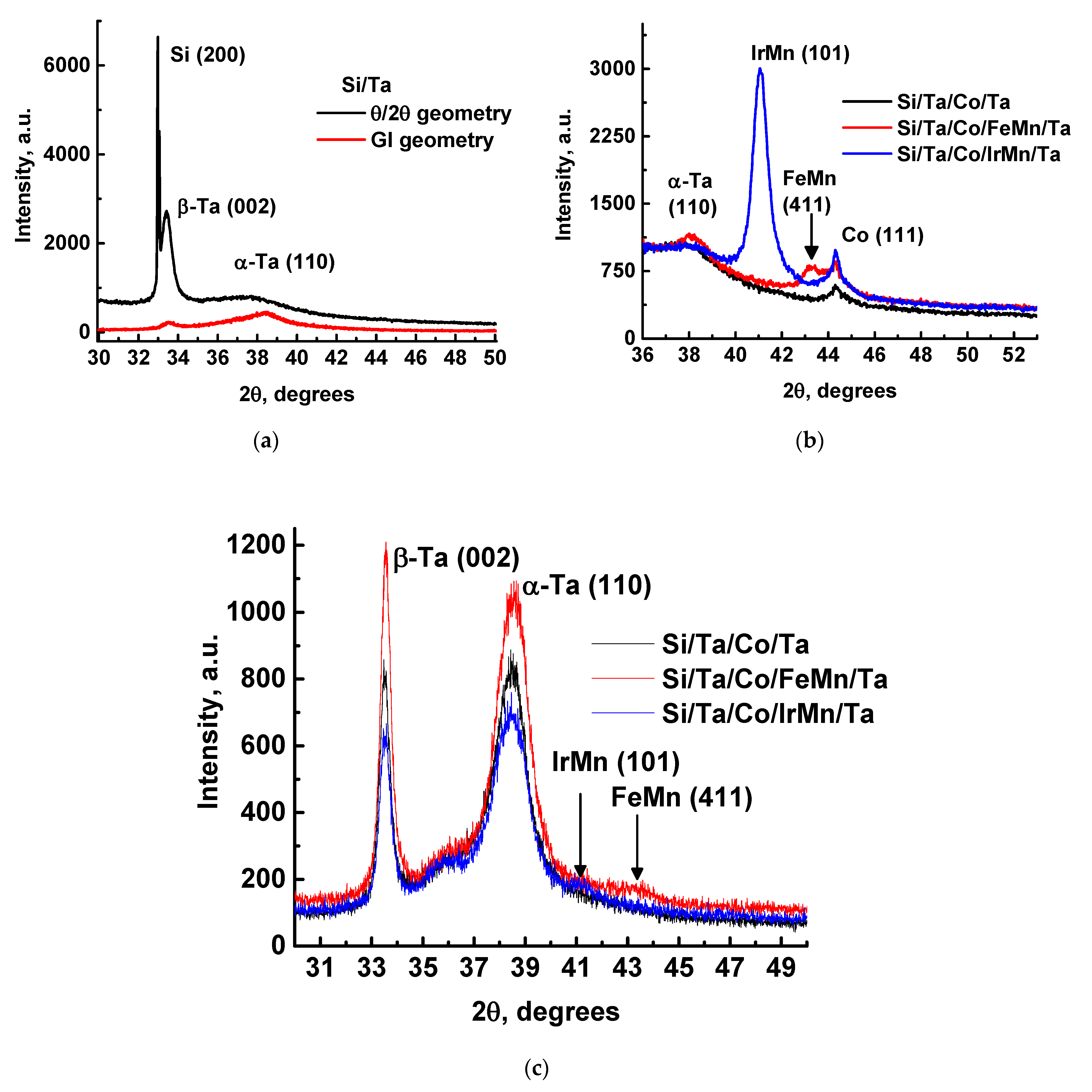




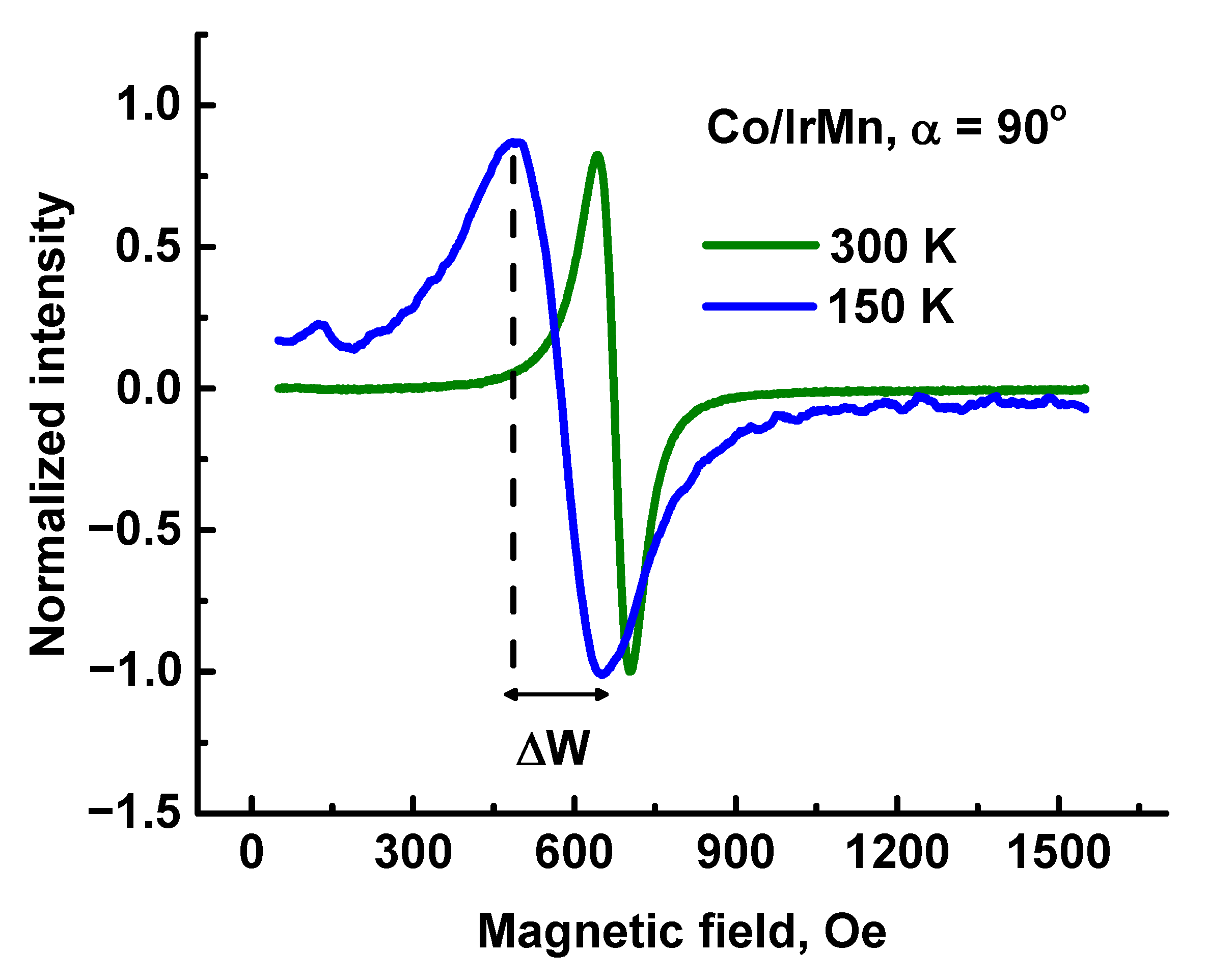
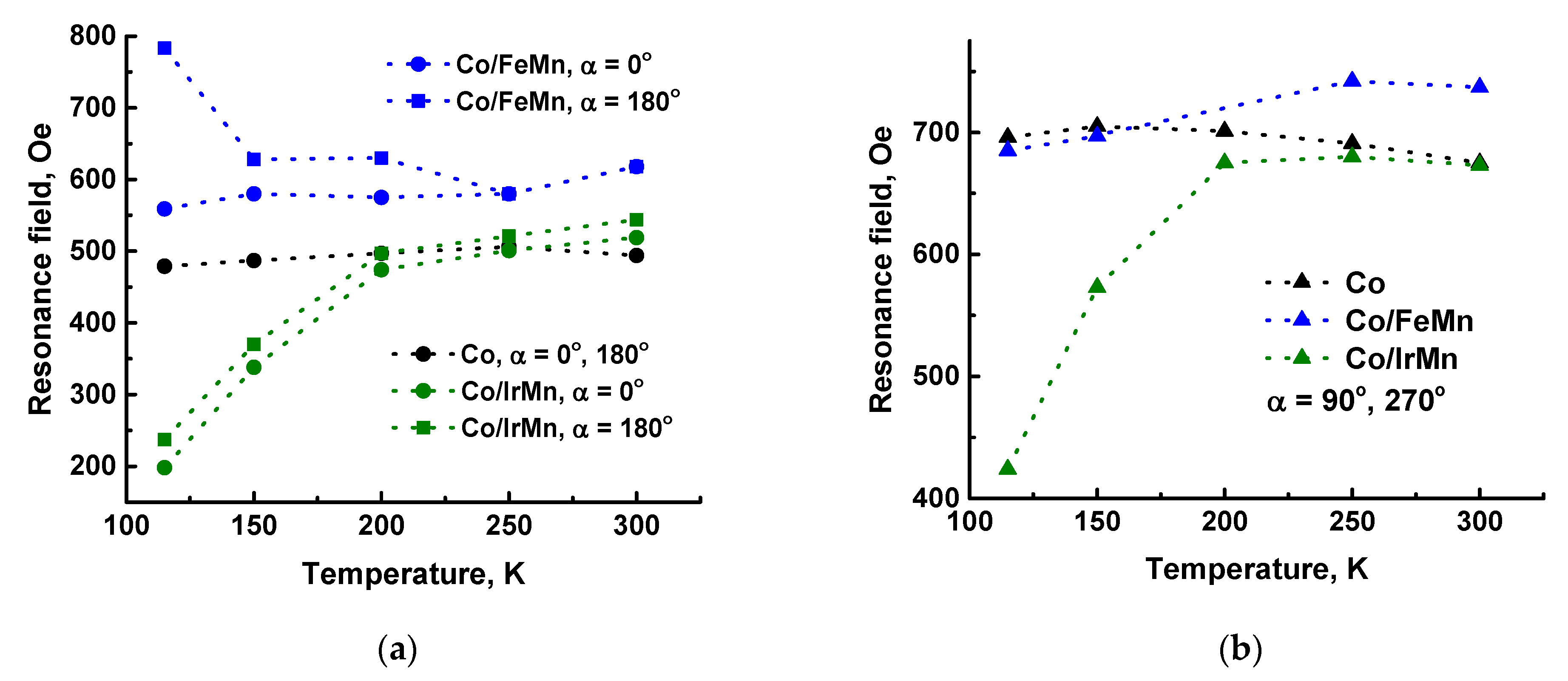


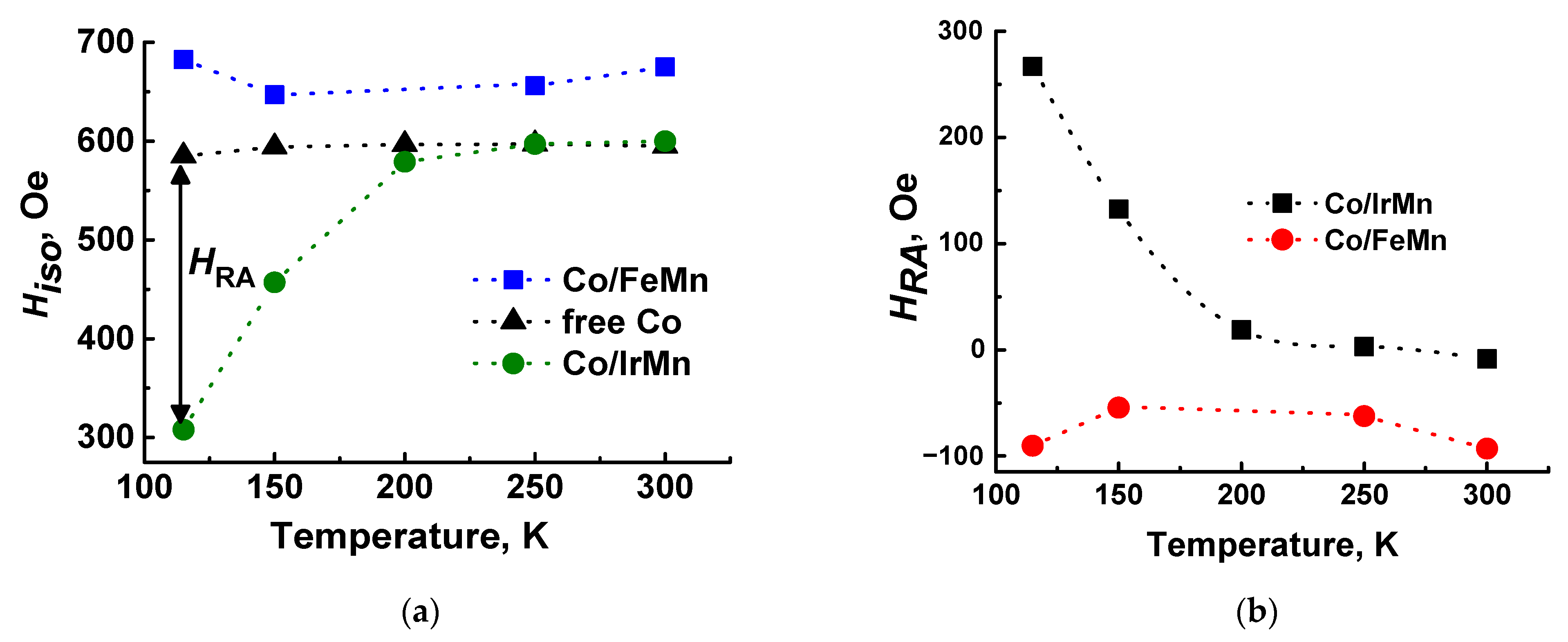
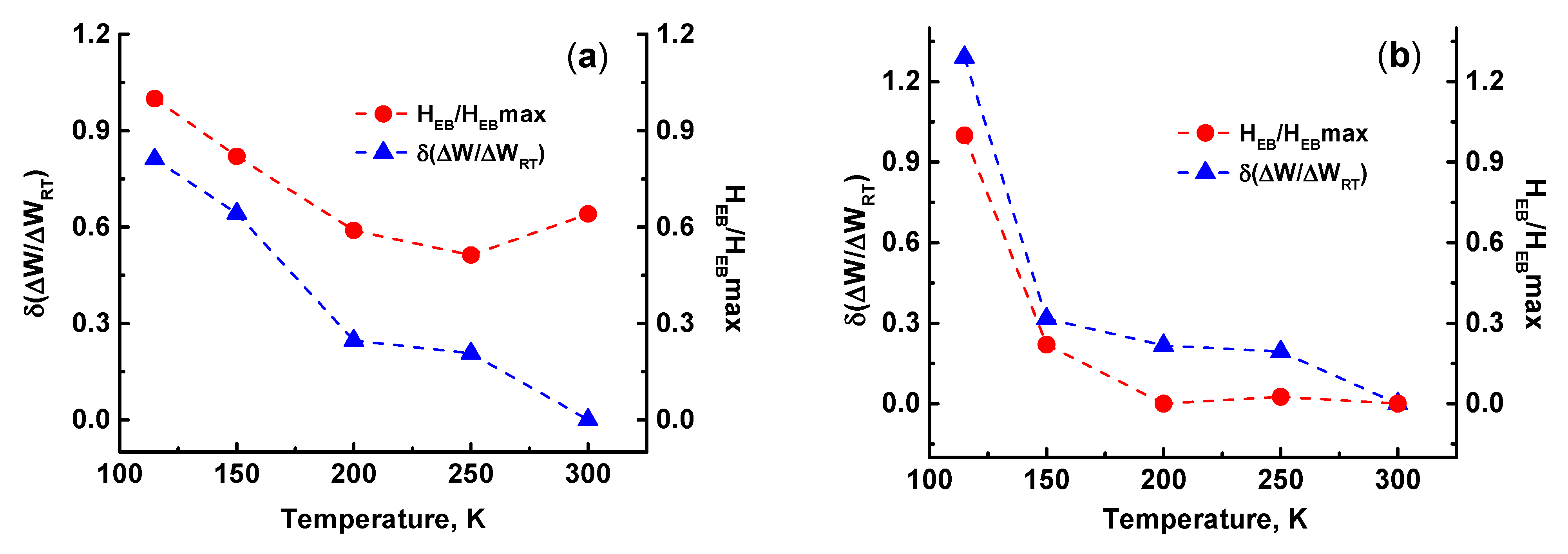
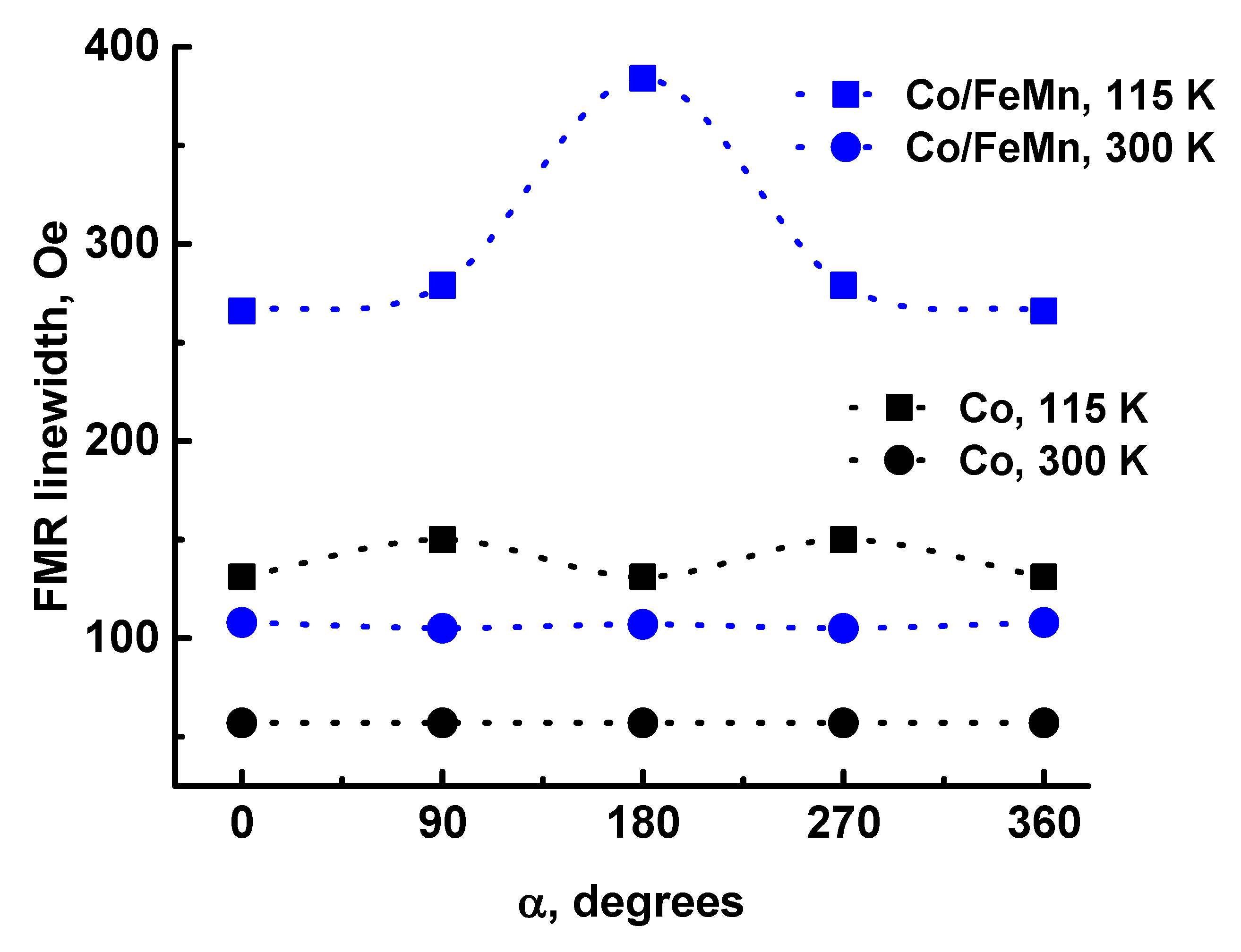
| Sample | RMS, nm | Ra, nm |
|---|---|---|
| Si/Ta | 0.47 | 0.36 |
| Si/Ta/Co | 0.71 | 0.53 |
| Si/Ta/Co/IrMn | 0.54 | 0.41 |
| Si/Ta/Co/FeMn | 0.27 | 0.20 |
| Sample | HEB FMR/VSM, Oe | HK FMR/VSM, Oe | Hc EA/HA, Oe |
|---|---|---|---|
| Free Co | - | 82/86 | 28/28 |
| Co/IrMn | 12/14 | 73/88 | 24/7 |
| Co/FeMn | 0/35 | 60/- | 50/- |
Disclaimer/Publisher’s Note: The statements, opinions and data contained in all publications are solely those of the individual author(s) and contributor(s) and not of MDPI and/or the editor(s). MDPI and/or the editor(s) disclaim responsibility for any injury to people or property resulting from any ideas, methods, instructions or products referred to in the content. |
© 2023 by the authors. Licensee MDPI, Basel, Switzerland. This article is an open access article distributed under the terms and conditions of the Creative Commons Attribution (CC BY) license (https://creativecommons.org/licenses/by/4.0/).
Share and Cite
Dzhun, I.O.; Gerasimenko, A.V.; Ezhov, A.A.; Bezzubov, S.I.; Rodionova, V.V.; Gritsenko, C.A.; Chechenin, N.G. Temperature Dependence of Magnetization Dynamics in Co/IrMn and Co/FeMn Exchange Biased Structures. Magnetochemistry 2023, 9, 218. https://doi.org/10.3390/magnetochemistry9100218
Dzhun IO, Gerasimenko AV, Ezhov AA, Bezzubov SI, Rodionova VV, Gritsenko CA, Chechenin NG. Temperature Dependence of Magnetization Dynamics in Co/IrMn and Co/FeMn Exchange Biased Structures. Magnetochemistry. 2023; 9(10):218. https://doi.org/10.3390/magnetochemistry9100218
Chicago/Turabian StyleDzhun, Irina O., Andrey V. Gerasimenko, Alexander A. Ezhov, Stanislav I. Bezzubov, Valeria V. Rodionova, Christina A. Gritsenko, and Nikolai G. Chechenin. 2023. "Temperature Dependence of Magnetization Dynamics in Co/IrMn and Co/FeMn Exchange Biased Structures" Magnetochemistry 9, no. 10: 218. https://doi.org/10.3390/magnetochemistry9100218
APA StyleDzhun, I. O., Gerasimenko, A. V., Ezhov, A. A., Bezzubov, S. I., Rodionova, V. V., Gritsenko, C. A., & Chechenin, N. G. (2023). Temperature Dependence of Magnetization Dynamics in Co/IrMn and Co/FeMn Exchange Biased Structures. Magnetochemistry, 9(10), 218. https://doi.org/10.3390/magnetochemistry9100218









